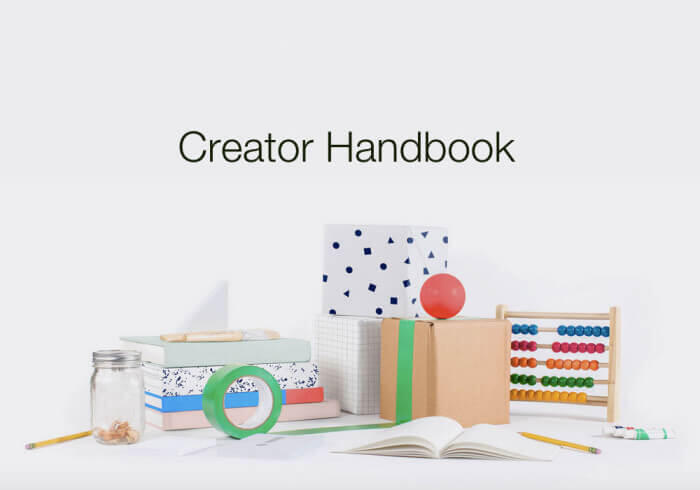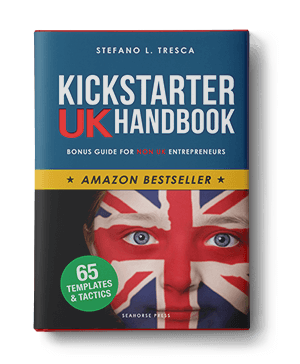★ ★ ★ ★ ★
Tricks and data I've never found anywhere else.
Amazon USA
★ ★ ★ ★ ★
Very useful book for those young entrepreneurs in need of alternative way of raising money.
Amazon UK
★ ★ ★ ★ ★
This book covers every aspect of a crowdfunding campaign, it is not just about Kickstarter.
Amazon Italy

About the Author
Stefano L. Tresca was employee #8 at Wind, a telecom and internet company sold for $12.1 billion.Today Stefano serves as a non-exec director and advisor for crypto funds and blockchain companies.He has founded the Impact in Tech Foundation, and he's passionate about improving financial inclusion through technology, impact investing, and education.Many years ago, he fell in love with the city of London, and that's where he lives now when he's not traveling.Feel free to contact him on Twitter or LinkedIn, or check his website.
Full Chapter List
Read the
Free Chapter
4+1 Questions to Ask Before Joining Kickstarter
10 Things to Do Before Kickstarter
3. Estimate the Cost
Free Chapter
13 Hacks for Making a Successful Video
Creating Your Media List
You Have a List of Bloggers, Now What?
Move Your Media List to the Next Level
How to Set Up Pledges That Sell
8 Things to Do at the Beginning of Your Campaign
12 Marketing Hacks for Your Campaign
6 Things to Do After the Campaign Ends
Kickstarter UK for Non British
Templates
Useful Links and Resources
True Stories and Case Studies
(In alphabetical order)
Amanda Palmer: The new RECORD, ART BOOK, and TOUR
(By Amanda Palmer)
http://kck.st/JliwH9
Bring Reading Rainbow Back for Every Child, Everywhere!
(By LeVar Burton)
http://kck.st/1kKwSrD
Double Fine Adventure
(By Double Fine and Two Player Productions)
http://kck.st/A9k3jH
Ego Smart Mouse
(By Laura Sapiens)
http://kck.st/13jNyOV
Elevation Dock: The Best Dock For iPhone
(By Casey Hopkins)
http://kck.st/uu4Ty8
Good & Proper Tea: London-based loose-leaf brew bar
(By Emilie Holmes)
http://kck.st/WZWZQl
Loka: the world of fantasy chess
(By Alessio Cavatore and Mantic Games)
http://kck.st/X2Paci
Matter
(By Jim Giles, Bobbie Johnson and Matter)
http://kck.st/Aonvvh
Metal Gear Solid: Philanthropy.
New movie: coming soon.
Existing movie (2009)
http://www.hivedivision.net/en/portfolio/mgs-philanthropy/
Minaal Carry-on: travel faster, happier & more productive
(By Doug Barber and Jimmy Hayes)
http://kck.st/14YVmaZ
Oculus Rift: Step Into the Game
(By Oculus)
http://kck.st/NU6QRn
OwnPhones: Wireless, Custom-Fit, 3D Printed Earbuds
(By Itamar Joban and others)
http://kck.st/1p6JuZQ
Pebble: E-Paper Watch for iPhone and Android
(By Eric Migicovsky and Pebble Technology)
http://kck.st/HumIV5
Petcube - Stay closer to your pet
(By Yaroslav Azhnyuk and Petcube Inc)
http://kck.st/1b2kop5
Prodigy the Game
(By Hanakai Studio and Jean Bey)
http://kck.st/1lnbPdu
RAIN: a fan film about Storm
(By Maya Glick)
http://kck.st/1sLbw3a
Reaper Miniatures Bones II
(By Reaper Miniatures)
http://kck.st/1712ejw
Rebuild: Gangs of Deadsville
(By Sarah Northway)
http://kck.st/1bomFhU
SCiO: Your Sixth Sense. A Pocket Molecular Sensor For All
(By Consumer Physics, Inc.)
http://kck.st/1hPqZ6I
SHADOW | Community of Dreamers
(By Hunter Lee Soik)
http://kck.st/16asGpx
Soma - Beautifully innovative all-natural water filters
(By Soma)
http://kck.st/VjAFva
Star Citizen (By Chris Roberts).
They raised $55 million on a proprietary platform: http://robertsspaceindustries.com
An initial round of “just” $2.1 million was raised on Kickstarter:
http://kck.st/RXG0Z8
Start Trek: Axanar
(By Axanar Production and Alex Peters)
http://kck.st/1xc0Bwr
Stem Cell Trial for Multiple Sclerosis
(By Tisch MS Center)
http://igg.me/p/696737/x/2082976
The Coolest Cooler (By Ruan Greeper)
First campaign (unsuccessful):
http://kck.st/1hfaWUu
Second campaign:
http://kck.st/1oweGkH
The Great Kingdom, the Creation of Dungeons & Dragons
(By Andrew Pascal and Others)
https://www.kickstarter.com/projects/720223857/the-great-kingdom
The Seed
(By Misery Dev. Ltd and Nicolai Aaroe)
http://kck.st/1mfsx19
The Veronica Mars Movie Project
(By Rob Thomas)
http://kck.st/Z1HJRR
Ubuntu Edge
(By Canonical)
http://igg.me/at/ubuntuedge
Urban Heroes
(By Tin Hat Games)
http://kck.st/PweJ4N
10 Things to Do Before Kickstarter:
#3 Estimate the Cost

“Don’t ask for what you want. Ask for what you need.
— CROWDFUNDING 101
Kickstarter is a “win-all/lose-all” platform. If you reach 99.99% of your goal you don’t get anything. ZERO. On the other hand, you could raise more than 100% of your goal. Think back to Reaper Miniatures who raised 10,565% of their initial goal, more than 100 times what they needed.Despite the long list of Kickstarter successes, there is one piece of information rarely made public. Many entrepreneurs lose money on Kickstarter, even when their campaign is successful, or–should I say–because their campaign is successful. Unexpected international shipping costs and inconsistent quotes from manufacturers are the main two reasons for this failure.Here is a list of costs to consider and some tips for reducing your risk.1. Manufacturer cost (of course). If you haven’t used the manufacturer before don’t assume that their time and cost estimation is anywhere near the truth. Befriend and ask other entrepreneurs producing a similar product instead. Websites like Alibaba could be particularly helpful.If you have a digital product, you don’t have traditional manufacture problems or a shipping issue. But unless you develop everything by yourself you will still have to deal with programmers and such. Try to involve an experienced project manager, or–if you don’t have the budget–befriend and chat with a couple of them. Buy them dinner or a drink; this will be one of the best investments of your campaign (and eventually you may make a new friend).2. Shipping cost. Hint: don’t consider the weight of your product alone. Consider the wrapping and the box, plus any other gadgets you promised to include.3. Duties. Don’t forget that many countries will charge duty on imports. Digital products don’t usually have this issue and it’s the same for books and comics (but beware of shipping a comic which contains nudity to some countries; the consequence can be much worse than a duty tax). The websites and local branches of UPS, DHL, or other providers can be very helpful. It’s a complex matter, so it’s better to check different sources.4. Storage. A warehouse could be more expensive than you think.5. Kickstarter commission and other fees. When your project reaches its goal, Kickstarter takes a 5% fee for each successful charge. If you go through Amazon Payments you will get charged another 3%-5%.6. Credit card refund. If the charge is unsuccessful because the backer has an issue with his credit card or simply decides to cancel his support, you don’t get anything from them. Between the Kickstarter commission, Amazon and/or credit card fees, and unsuccessful charges, you should consider a total cost of 15%-20%.#TIP — As a rule of thumb, calculate all necessary costs and add 20%. That’s your initial goal.CALL TO ACTION. Do you have any other experiences not included in the list? Contact me and I’ll update your suggestions in the book, citing your name (if you like). The best way is through Twitter @startupagora or my website http://startupagora.com/help.

Rules and Tips by Kickstarter
DON’T ASK FOR MORE BUT AIM FOR MORE
If you don’t reach your goal even by one cent you don’t get anything. Aim low and ask for exactly what you need to cover your costs. You can always raise more than your goal.In fact, a limited goal could help you to raise more. It’s easier to reach 40% of a small sum and this percentage is usually the trigger that pushes more backers to support your project–nobody wants to side with losers. Once these backers help you reach 100% of your (limited) target it’s easier to convince bloggers and online magazines to write about you – and that drives even more backers to your project.
EXCEPTION TO THE RULE
Kickstarter is not just a fund raising platform but also a great marketing tool. If you plan on developing your product anyway it could be convenient to set a goal smaller than you need.If you “just” reach your goal you’ll have to put your own money into the product, but you would have invested your money anyway. Kickstarter provides a down payment and an incredible marketing window. And if you raise more than your goal, you can eventually cover all the costs.The opposite is also true although unusual. In some rare cases, the project creator sets an impossible goal to reach in order to create buzz and free promotion. They are not ready to create the product so they use Kickstarter to “test the water” and create some buzz for the future.I’m not recommending this strategy; I just believe that it has been used before. Ubuntu Edge—a campaign I supported on Indiegogo—raised more than $12 million and still failed. They set an impressive goal of $32 million. I don’t know if they planned on a high chance of failure from the beginning, but they got impressive coverage throughout traditional and social media.
Read another FREE chapter
3 Hacks from Veronica Mars – A Kickstarter Case Study »
© Seahorse Press yeardate | Privacy | Contact | Contents made available under a Creative Commons Licence. You must attribute the work to Kickstarterukhandbook.com.
3 Hacks from Veronica Mars – A Kickstarter Case Study

“When the going gets tough, the tough get going.
— JOHN BELUSHI (Animal House)
The image below is from the Veronica Mars campaign, one of the top Kickstarter case studies of all time. Kristen Bell announces that they have just hit the $5 million mark.Time to celebrate and enjoy the success, right?Wrong!

Kristen Bell raises $702,000 with a YouTube video
Kristen thanks the supporters for less than half of the video. Then she delivers the news. Yes they have broken the record for the highest amount of funding ever raised, but not the record for the highest number of backers. In other words, there are projects out there with less money but more supporters.Hey, that’s terrible!So Kristen invites every backer to convince one friend to make a $1 pledge. Even if they don’t have the budget or are not interested in the movie, they can still make a difference. After all $1 is a small price to pay for your friendship.In case you are curious, after this message the campaign raised an extra $702,000. Not all the funds came from the $1 pledges, but they surely played their part. Not a bad result for a few minutes in front of your webcam, don’t you think?
3 HACKS WITH 1 CLICK: A KICKSTARTER CASE STUDY
There is one obvious lesson to learn from Kristen’s video.1. Ask for the help of your backers, it’s simple as that.
But there is more.2. Don’t just ask for help, provide detailed instructions.3. Use a small pledge to get email addresses.
These points both deserve their own chapter, and this is exactly what I’m going to do in the next lines. In the meantime, enjoy the message and take note. Even seasoned sales guy could learn a thing or two from her.
The Veronica Mars Movie Project (by Rob Thomas)
http://kck.st/Z1HJRR
DON’T JUST ASK FOR HELP, GIVE THEM A WISH LIST
“I hear and I forget;
I see and I remember;
I do and I understand.
— CHINESE PROVERB
Veronica Mars didn’t ask for generic help. The request was extremely specific: “Ask your friend to pledge $1”.Fans tend to react best when they have clear instructions. Sure, there will always be someone more creative developing their own tactics. You don’t send your message to these supporters; in fact they will find a way to help you in any case. You send a specific suggestion to anybody else, including someone who is usually creative but simply too tired or too busy.The easier you make the life of your backers, the more they’ll expend time and energy to support you.In our example suggesting a pledge of $1 is brilliant. The sum is small enough to not scare anybody and you don’t risk losing the higher pledges; on the contrary, once the friends of your backers are on your page they can decide to spend more.
USE A SMALL PLEDGE TO GET THEIR EMAILS
“Anyone who has never made a mistake has never tried anything new.
— ALBERT EINSTEIN
For the sake of privacy you don’t have access to the email addresses of your backers, but you can still use Kickstarter to send direct messages to them. Team Veronica Mars gained access to hundreds of thousands of email addresses with their $1 message.Even if the sum is small you can reach all your backers, and you have until the end of the campaign to convince them to upgrade their pledge. I’m not talking spamming here. Sending exciting updates works like a charm.In the meantime they can share your updates with their friends and social media. It’s an army of evangelists; one of the most effective marketing engines and one of the most rewarding experiences from a personal point of view. Don’t ignore them, don’t spam them, instead cuddle them and feed them with amazing updates, videos and funny emails.
Read another FREE chapter
Which Video Sells the Most on Kickstarter? »
© Seahorse Press yeardate | Privacy | Contact | Contents made available under a Creative Commons Licence. You must attribute the work to Kickstarterukhandbook.com.
Which Video Sells the Most on Kickstarter?

“Humor comes from self-confidence.
— RITA MAE BROWN
I’m often asked what themes sell the most in a video. Short answer: humor.There is a famous quote from Rita Mae Brown “Humor comes from self-confidence”. The contrary is also true. The less confident you are the more you try to compensate and end up looking stilted and overly professional. The sad consequence is a long line of videos with the speaker looking like a bad imitation of Mark Zuckerberg.Kickstarter is not pitching to the venture capitalists in Silicon Valley. Besides, humor can help in front of the investor as well. I’ve seen it many times. Check out Drew Houston, the founder of Dropbox, you can find his application to the startup accelerator YCombinator on the internet (Google “Drew Houston Dropbox application YCombinator”). The tone is funny and informal and you can read a couple of jokes too.Go back to LeVar Burton’s video where he enters schools by surprise and enjoys the reactions of the teachers. It’s staged but who cares. It’s funny!

Ok the shock looks staged, still the video is funny.
WHICH VIDEO SELLS SECOND BEST?
Perhaps humor won’t work for your project, although I doubt it. In this case there will be no ‘second best’ theme. You have to find the theme most appropriate for your project.However no matter the theme you choose never ever look overly professional. There is a slogan we often repeat in consultancy. It’s “Crowd + funding” not “Crowd funding YOU”. You are either part of the crowd or outside the crowd. In the latter case it’s very unlikely that anybody will care about your project.
Read another FREE chapter
How To Setup a Kickstarter Pledge: the Inside Backer »
© Seahorse Press yeardate | Privacy | Contact | Contents made available under a Creative Commons Licence. You must attribute the work to Kickstarterukhandbook.com.
How To Setup a Kickstarter Pledge: the Inside Backer

“My greatest fear is not that i set the standard to high and fail to reach it, but that i set it too low and achieve it.
— MICHELANGELO (1475 – 1564)
The “Inside Backer” is one of the most successful Kickstarter pledge and it’s almost free for you.I am sure you have seen this kind of reward many times. Offer a limited number of backers the chance to be part of your product. If you are an author you can give a character their name or the name of their loved ones. If you are launching a gaming app, you can give their face to a minor character (medium pledge), a main character (expensive pledge) or the princess and the hero (very expensive pledge).

They didn’t say anything about the backers, however The Oatmeal is (in)famous to design his readers as monsters.
This hack has been used a long time before Kickstarter, and when I say “a long time” I really mean that. In the 16th century, Michelangelo portrayed many celebrities of his time as angels or saints on the Sistine Chapel in Rome. We don’t have prove that he get funded but it’s quite possible. If this “pledge” worked for Michelangelo, I’m sure it will work for you.#TRIVIA — Michelangelo painted the ceiling of the Sistine Chapel working non-stop for four years (1508-1512). In the masterpiece, he left at least two self portraits and the faces of many celebrities of his time. One of the self portraits is hidden in the scene of St Bartholomew holding the skin of a man flayed alive. Ironically, Michelangelo didn’t paint his face on the saint but on the tortured man. This is his unconventional way of complaining to his boss—the Pope—about working four years non-stop, without weekends or holidays.

Michelangelo didn’t paint his face on the saint but on the tortured man
On the contrary, one of the “celebrities” is in hell, with donkey ears and a snake biting his genitals. The face is Baigio da Cenesa, the papal master of ceremonies. The cardinal complained to the Pope about the excessive nudity in the painting, demanding a cover up. Not only did Michelangelo ignore the request, but the memory of the cardinal is mocked in front of 25,000 tourists a day. Now that’s true revenge!
Read another FREE chapter
What Is the Best Duration for a Kickstarter Campaign »
or buy the book to read about all the other pledges:
Early Bird
Thank You Pledge
The Baker Borne Pledge
Limited Edition Pledge
Stretch Goals
Case Study: OwnPhones
Case Study: SCIO Your Sixth Sense
© Seahorse Press yeardate | Privacy | Contact | Contents made available under a Creative Commons Licence. You must attribute the work to Kickstarterukhandbook.com.
What Is the Best Duration for a Kickstarter Campaign

“Nine women can’t make a baby in a month.
— MARK SUSTER (Serial Entrepreneur and VC)
At this point, your project has been accepted by Kickstarter, and you need to decide upon the length of your campaign. In theory, you can pick any life span from 1 day to 60 days, however the most successful campaigns are one month long.#TIP — The most successful campaigns on Kickstarter are 30 days long.We all fantasise about raising more money using the entire time frame of 60 days, but this could be a huge mistake. Every expert salesman knows that he has a better chance of closing a deal if he instills a sense of urgency in the buyer. This is true for crowdfunding as well.Kickstarter proved this theory changing their Terms of Service after two years of experimenting. Until 2011 campaigns were allowed to last up to 90 days, but this option was removed due to poor performance. Only 24% of the long campaigns were successful; a nice way of saying that 3 out of 4 were a complete failure. On the contrary, the overall success of the shorter campaigns was almost double.Look at the graph “Project Duration vs. Success Rate” created by Kickstarter; it’s quite convincing.

Campaign duration vs. Success rate (Source: Kickstarter)
THE EXCEPTION TO THE RULE
When a campaign needs to raise a limited amount of money, for instance $5,000, I’ve seen a high ratio of success with a length of 3 weeks. This is especially true for small campaigns who aim to finance books and comics as it is likely that the backers won’t want to wait too long to read the end product.It’s possible that your campaign could work better using the entire time frame of 60 days, although I doubt it. Feel free to pick a different length, if you truly feel that you are an exception to the rule. After all, making exceptions to the rule is what makes great entrepreneurs. You know what they say.
“The bad entrepreneur ignores the rules. The good entrepreneur knows the rules. The great entrepreneur learns the rules to understand which ones to break.
Read another FREE chapter
What Is the Best Month to Start a Kickstarter Campaign? »
© Seahorse Press yeardate | Privacy | Contact | Contents made available under a Creative Commons Licence. You must attribute the work to Kickstarterukhandbook.com.
What Is the Best Month to Start a Kickstarter Campaign?

There are many books and articles about the “How” in crowdfunding (How to start a campaign; How to pitch a journalist; etc.) but not much about the “When”.For instance, what about launching a campaign during Christmas? Is it a good idea because customers are looking to buy presents, or is it a bad decision because they have already spent all their money? Sometimes the “When” could be just as important as the “How”.We survey every category on a regular basis. In this post, I’m going to share with you the results of the category “Tech”. Join the newsletter for regular updates in each category.It may looks like a huge analysis (indeed it is with 21,386 campaigns in 2014) but fundraising for startups is part of my job, so my team and I are a bit fanatical when it comes to data.
Kickstarter Analytics
[Year: 2014 / Category: Technology]
NUMBER OF CAMPAIGNS SUCCESSFULLY CLOSED BY MONTH
January 62 (5.55%)
February 55 (4.92%)
March 66 (5.91%)
April 74 (6.62%)
May 89 (7.97%)
June 73 (6.54%)
July 112 (10.03%)
August 109 (9.76%)
September 122 (10.92%)
October 111 (9.94%)
November 110 (9.85%)
December 134 (12.00%)
——————————
Total 1117
Best month: DecemberDecember performs better if your campaign closes in time to ship your product before Christmas. Therefore, most of the campaigns that aim to leverage Christmas start in November.On the contrary, the campaigns starting in December end sometimes in January or February, the months with the smallest number of successful closings. This is an indication that December and January tend to be bad months to start a campaign because the customers have spent their money already and/or are on holiday.
TOTAL FUNDRAISING PER MONTH (IN USD)
January $6,632,916
February $5,339,616
March $5,005,904
April $11,491,853
May $9,799,798
June $9,728,904
July $17,704,052
August $9,254,059
September $8,083,001
October $5,012,076
November $7,127,342
December $10,581,206
——————————
Best month: JulyJuly 2014 happened to be the closing month for “Bring Reading Rainbow Back for Every Child, Everywhere!” by LeVar Burton (Captain Geordi La Forge in Star Trek, and host of the popular TV show Reading Rainbow). This campaign alone raised $5,408,916, almost one third of the entire fundraising of the month.
AVERAGE FUNDRAISING PER CAMPAIGN (IN USD)
January $106,993
February $98,882
March $75,847
April $155,295
May $110,110
June $133,273
July $158,072
August $84,900
September $66,252
October $43,996
November $64,794
December $78,964
——————————
Best month: July
CURIOUS FACTS
Smallest goal: $1
Campaign “Tucker…the last human invention” by Brian Kent
http://kck.st/1rb4FznBigger goal: $1,000,000
Campaign “Bring Reading Rainbow Back for Every Child, Everywhere!” by LeVar Burton & Reading Rainbow
http://kck.st/1kKwSrDBigger Fundraising: $6,225,354
Campaign “Pono Music – Where Your Soul Rediscovers Music” by the PonoMusic Team
http://kck.st/1g5xVf3

First Edition PonoPlayers: Black & Yellow
MORE KICKSTARTER STATS
Kickstarter website provides some of its own stats as well
https://www.kickstarter.com/help/statsSweet! Register to the newsletter to get the stats from the other categories, and prepare for your project.
Read another FREE chapter
How to Open a UK Limited Company (not just) for Kickstarter »
© Seahorse Press yeardate | Privacy | Contact | Contents made available under a Creative Commons Licence. You must attribute the work to Kickstarterukhandbook.com.
How to Open a UK Limited Company (not just) for Kickstarter

“Being realistic is the most common and travelled road to mediocrity. Why you want to be realistic?
— WILL SMITH
I am not going to write a long legal paper about company formation, as this is not the goal of the book. I am simply going to stress a couple of practical tips that traditional lawyers often ignore. They may be useful even if you have a company already.The usual warning is also valid. If you want to start a serious business, it may be worth seeking the help of a lawyer, or at least an accountant (you are going to pay one of them anyway for your bookkeeping when the Kickstarter campaign ends).This short chapter doesn’t want to dismiss the benefit of lawyers, but it could help you to understand whether the professional in front of you is the right one for your project. Some attorneys are really good with traditional companies, but they may not understand that a startup is different from a traditional company, and it has different requirements.
WHAT KIND OF UK COMPANY YOU HAVE TO CHOOSE
There are different kinds of companies in the UK: limited companies, joint stock companies, limited partnerships and sole traders, to mention the most common ones.Sometimes I’m asked what the best type of company to choose for Kickstarter is. My answer is always the same: a limited company.Partnerships are a disaster when raising funds from investors. Sole traders are too risky and again not suitable to raise funds. Joint stock companies are more expensive and you don’t need them at this stage.This is valid for almost every entrepreneur, but exceptions exist. Therefore, it may be worth having a chat with a lawyer, especially if you start your business with an important budget.
HOW TO SET UP A UK LIMITED COMPANY
Starting a limited company is very simple in the UK, and you probably already know how to do it. You can register a company online with the government body Companies House (https://www.gov.uk/register-a-company-online) or with a private provider (I have made a list at http://startupagora.com/uk-company-formation).#TIP — The main advantage of a (major) private provider is that you can access your company online immediately after the formation. You can add new directors, new shareholders, change your office address and so on from day one.Ironically, if you open your company directly with the government body—Company House—you won’t have immediate access to it. They will send your online password by post to your physical address. Until you receive this letter, you can’t make any changes to your company. As a consequence, if you set up your company through Companies House, it’s important that you set up your office (or virtual office) in advance, or your password will get lost.I’m not going into detail about the formation, because the process is quite straightforward. If you have never opened a company in the UK, don’t worry, you can still do it. The Companies House website, or the private provider, will ask you basic information such as the name of the company, the name and address of the directors, and so on. Fill in the fields, pay with PayPal or with your credit card, and start trading. That’s it.If you want to avoid even this minor fee, you probably can. Many UK accountants help their new customers to start a company for free. You just have to find one on the Internet or through word of mouth (if you want to be introduced to mine, feel free to contact me).Personally, I prefer to NOT put all my eggs in one basket. I ask the accountant to focus on their accountancy services, and they don’t have the password to change the shareholders in my companies. But I may be a bit paranoid, and many entrepreneurs I know have taken the opposite decision. They leave all the hassle in the hands of their accountants, and they are happy with that.
HOW TO REPLY TO THE ONLY TRICKY QUESTION
The only question that could take you by surprise during the formation process is about the “Articles of Association”. This is the charter of the company, and it provides the rules of many important activities, such as how to appoint directors, how to manage the shareholders vote, and other aspects about the life of your company.When you set up your company, they will ask you if you want to use a standard Articles of Association or a personalized one.The answer is simple: pick the standard document.Even if you want custom-made rules, pick the standard document as well.The reason is tricky. If you pick a standard Articles of Association, the Companies House’s software will incorporate your company in a few hours. One the contrary, if you have a custom-made document, a human employee will be required to check what you have done, and this could easily take ten days. It could take even more time too, if they have doubts about one of your articles and they start asking questions by letter.Even when we start sophisticated tech startups with angel investors and custom-made rules, we set up the company with a standard Articles of Association. As soon as the company is ready, we apply for a custom-made Articles of Association. This way, we can do business while the bureaucracy checks the personalized rules.The only exception I can think of is that if you start a company with an important investment and you are required to set up special rules from the beginning, but this is very rare in a company doing crowdfunding.
ONE LAST POINT: LAWYERS
If you need custom-made rules, this is the right moment to invest some of your money in a good lawyer. If the attorney is smart, he will not overcharge you in order to start a long-term relationship.
The cost could still be painful for a small business, but a cut and paste from the Internet will cost you much more in the long term.Actor Denny DeVito made me laugh to tears in his movie Other People’s Money. “Lawyers are like nuclear warheads,” he says, “they have theirs, so I have mine. Once you use them, they f*** up everything”.Well, a custom-made Articles of Association is an exception and Danny would agree with using a lawyer too.#TIP — When you open a UK company, always accept the standard Articles of Association. If you need a custom-made document, start the company with a standard template anyway and change it later.
A SHORT NOTE ABOUT THE SHARES
When you set up a company online, you’ll be asked how many ordinary shares of £1 you need. If you use an accountant or a lawyer, they will probably do the same.I will not go into legal details because—as an entrepreneur—you should focus on the business. You just need to know two things:
Shares don’t have to be of £1. They could be 1 cent (£0.01) and even smaller, up to 1/6 of a Pound (£0.000001);
Shares of £1 are usually NOT the best choice for a startup or a company looking for investors later. The smaller the share, the better. Again, I don’t want to confuse you with boring legal details.
#TIP — When you set up a tech company, or a company planning to raise funds later, small shares of £0.01 or even smaller could be the best choice. If the accountant or lawyer in front of you has no clue as to the reason why, they may not be as experienced as they say about your type of business.
Read another FREE chapter
Check the Full Chapter List in Home Page »
© Seahorse Press yeardate | Privacy | Contact | Contents made available under a Creative Commons Licence. You must attribute the work to Kickstarterukhandbook.com.
Privacy Policy
First and foremost, this website do NOT use cookies. At KickstarterUKHandbook.com, we respect your privacy, period.Log FilesLike any other Web sites under Google Analytics, KickstarterUKHandbook.com makes use of log files. The information inside the log files includes internet protocol ( IP ) addresses, type of browser, Internet Service Provider ( ISP ), date/time stamp, referring/exit pages, and number of clicks to analyze trends, administer the site, track user’s movement around the site, and gather demographic information.This information is NOT linked to any information that is personally identifiable.If you require any more information or have any questions about our privacy policy, please feel free to contact us by email at hello@kickstarterukhandbook.comDoubleClick DART CookieGoogle’s use of the DART cookie enables them (not us) to serve ads to users based on their visit to Web sites on the Internet, including our website. Users may opt-out of the use of the DART cookie by visiting the Google ad and content network privacy policy at the following URL – http://www.google.com/privacy_ads.htmlIf you wish to disable cookies, you may do so through your individual browser options. More detailed information about cookie management with specific web browsers can be found at the browsers’ respective websites.That’s all. We don’t need a long privacy policy because we hate spam as much as you do. If you require any more information or have any questions about our privacy policy, please feel free to contact us by email at hello@seahorse.press

Contact the Author
Stefano L Tresca
Twitter: @drstefanotrescaLinkedIn: Stefano Tresca
By Phone
Twice a week I'm available by phone at this discounted fee to help new business and plan crowdfunding campaigns.
In Person
Level 39
One Canada Square
London E14 5AB
United Kingdom
© Seahorse Press yeardate | Privacy | Contact | Contents made available under a Creative Commons Licence. You must attribute the work to Kickstarterukhandbook.com







































